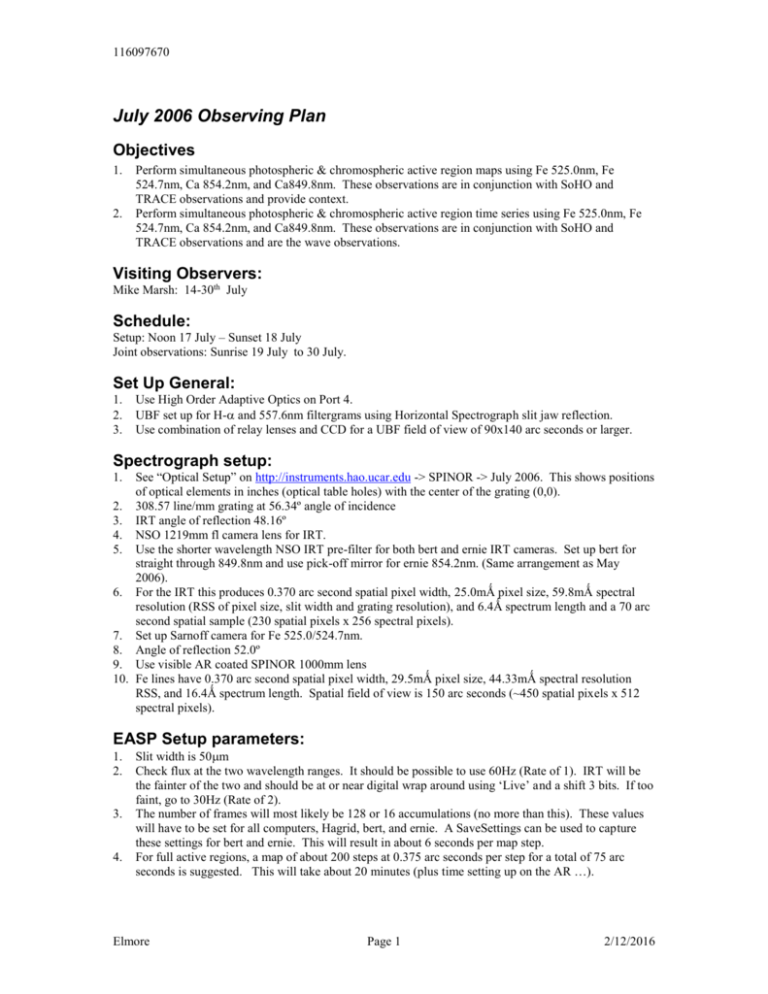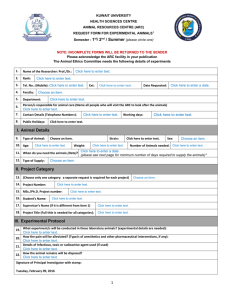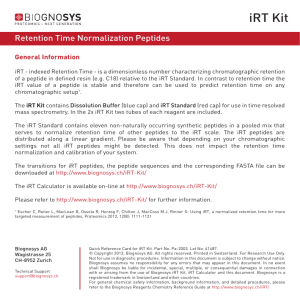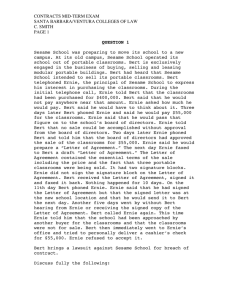SPINOR Observing Run Observing Plan
advertisement

116097670 July 2006 Observing Plan Objectives 1. 2. Perform simultaneous photospheric & chromospheric active region maps using Fe 525.0nm, Fe 524.7nm, Ca 854.2nm, and Ca849.8nm. These observations are in conjunction with SoHO and TRACE observations and provide context. Perform simultaneous photospheric & chromospheric active region time series using Fe 525.0nm, Fe 524.7nm, Ca 854.2nm, and Ca849.8nm. These observations are in conjunction with SoHO and TRACE observations and are the wave observations. Visiting Observers: Mike Marsh: 14-30th July Schedule: Setup: Noon 17 July – Sunset 18 July Joint observations: Sunrise 19 July to 30 July. Set Up General: 1. 2. 3. Use High Order Adaptive Optics on Port 4. UBF set up for H- and 557.6nm filtergrams using Horizontal Spectrograph slit jaw reflection. Use combination of relay lenses and CCD for a UBF field of view of 90x140 arc seconds or larger. Spectrograph setup: See “Optical Setup” on http://instruments.hao.ucar.edu -> SPINOR -> July 2006. This shows positions of optical elements in inches (optical table holes) with the center of the grating (0,0). 2. 308.57 line/mm grating at 56.34º angle of incidence 3. IRT angle of reflection 48.16º 4. NSO 1219mm fl camera lens for IRT. 5. Use the shorter wavelength NSO IRT pre-filter for both bert and ernie IRT cameras. Set up bert for straight through 849.8nm and use pick-off mirror for ernie 854.2nm. (Same arrangement as May 2006). 6. For the IRT this produces 0.370 arc second spatial pixel width, 25.0mǺ pixel size, 59.8mǺ spectral resolution (RSS of pixel size, slit width and grating resolution), and 6.4Ǻ spectrum length and a 70 arc second spatial sample (230 spatial pixels x 256 spectral pixels). 7. Set up Sarnoff camera for Fe 525.0/524.7nm. 8. Angle of reflection 52.0º 9. Use visible AR coated SPINOR 1000mm lens 10. Fe lines have 0.370 arc second spatial pixel width, 29.5mǺ pixel size, 44.33mǺ spectral resolution RSS, and 16.4Ǻ spectrum length. Spatial field of view is 150 arc seconds (~450 spatial pixels x 512 spectral pixels). 1. EASP Setup parameters: 1. 2. 3. 4. Slit width is 50m Check flux at the two wavelength ranges. It should be possible to use 60Hz (Rate of 1). IRT will be the fainter of the two and should be at or near digital wrap around using ‘Live’ and a shift 3 bits. If too faint, go to 30Hz (Rate of 2). The number of frames will most likely be 128 or 16 accumulations (no more than this). These values will have to be set for all computers, Hagrid, bert, and ernie. A SaveSettings can be used to capture these settings for bert and ernie. This will result in about 6 seconds per map step. For full active regions, a map of about 200 steps at 0.375 arc seconds per step for a total of 75 arc seconds is suggested. This will take about 20 minutes (plus time setting up on the AR …). Elmore Page 1 2/12/2016 116097670 5. 6. 7. For time-series, a map of about 10 steps at 0.375 arc seconds will take about a minute. Perform a movie of these for about an hour (60 repeats). Check the timing with the modulation rate that is picked. Create a UBF file on cookie for 557.6nm red wind, 557.6nm blue wind, H-H-red wing andHblue wing Create camera_init and camera_scan files on cookie to match the UBF file with correct exposure times for each wavelength. Data: ASP data go onto 8-mm tape. Tapes go to the scientists as they leave. Slit jaw images go to DLT during the run. DLTs leave with associated scientists. Tapes are ti be returned to NSO once data have been archived. Hagrid sends data to its local disc drive in real-time. Scientists will copy data from Hagrid, to their own USB disc drives. They must do this after daily observing, not to interfere with data collection. Scientists should remove data from the D:/ drive to leave at least 100GB free for the next day’s observations. - End- Elmore Page 2 2/12/2016











